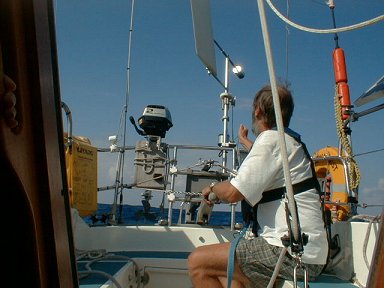
Note that I have re-mounted our stern-light onto the assembly which provides these lines: The Schwing-Pilot was initially masking some of the light's arc.

"If the anchor isn't looking after your boat, the self-steering is..." I have known this old quote from some grizzled long-distance yachtsman for many years. For most of those years, my boat was either moored to four ground-chains and drying out on legs every tide, safely alongside a marina pontoon or hauled out on a quay. At last it seems to be true, as we sit in the middle Carlisle Bay, Barbados with quite a fur of weed growing on the anchor chain.
 |
|
Three 4 mm lines control the Schwin-Pilot system. Two provide remote control of the course adjustment wheel - about one foot of line represents a ten-degree turn. The last is dyed blue and a sharp pull disengages the self-steering entirely. Note that I have re-mounted our stern-light onto the assembly which provides these lines: The Schwing-Pilot was initially masking some of the light's arc. |
The self-steering that brought us through the last four and a half thousand miles to this point was made for Rusalka Mist by Schwing Hydraulik Elektronik GmbH of Herne, Germany in 1995. Schwing are not famous for their windvane steering systems. They are a very large German engineering manufacturer with, I believe, around 5000 employees taking up most of the town of Herne. The gear is unique in some ways and, on the whole, very well designed and built.
It has a heavy GRP windvane which rotates around a vertical axis, not flipping down about a more-or-less horizontal axis as many current designs. This may not generate the power that a flip-down design will, but it is strong and less likely to be broken by breaking seas. Unlike owners of gears with thin plywood vanes, we can carry no spare as the assembly is too big and angular for storage below. This is not a problem as I can see no way it will be damaged. Under severe duress the stainless steel axis tube may bend. This would be a complete disaster as there are two or three concentric, free-turning tubes here and a severe bend would irrevocably jam the whole mechanism. The tubes bear on internal self-lubricating plastic bushes so there is very little friction and some tolerance to errors in the geometry. We have had quite severe boarding seas during the Atlantic crossing and there are no problems here at the moment.
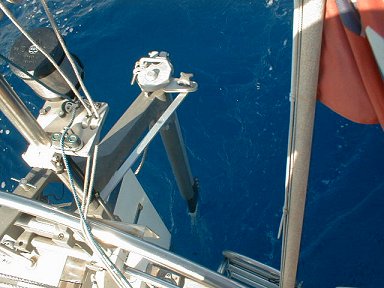 |
| The energy needed to move the tiller is provided by this paddle. When on course, you connect the tiller to the chain which moves it at the correct link, so that the paddle is centred behind the boat. |
The system may be unique in that the paddle which provides the motive power to move the tiller also rotates about a vertical axis. Let me explain. If you hold an oar straight down into the water over the back of a moving boat you will find that a slight twist of the handle to left or right will cause the oar to be driven powerfully to the side. If you hang on, it will, more than likely, twist your arm so as to pivot in a pendulum-like way. This is the way the paddle of most wind-vane steering gears translate a change in apparent wind into a movement that can be harnessed to move the tiller to re-position the apparent wind.
Let me return to the example involving the oar over the back: If you could hang on to the oar very firmly with both hands and prevent the pendulum-swing, instead of twisting your single arm, it would then try to rotate your whole body. This is the vertical axis of the Schwing's mechanism. Its designers say that this feature prevents the pendulum action from bringing the paddle to the surface as the boat heels in rougher conditions. I can believe that this could be problem with servo-pendulum designs. It is not an issue with the Schwing, the paddle always remains deep. The large, solid, heavily-anodised aluminium castings which govern this action are more than adequately strong enough for the job.
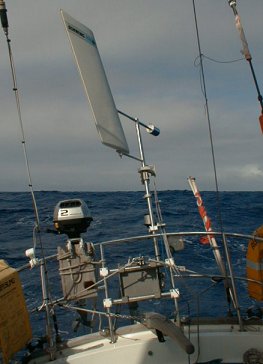 |
|
With plenty of wind and fairly reduced sail there is both enough wind over the deck and enough water-speed past the paddle for the Sching-Pilot to efficiently steer us downwind. There is a 'gain' adjustment on the unit, but we have never seen 'hunting' so I have it permanently set on maximum. Hunting is a control-theory concept describing the behaviour a system with too much gain - the course would swing either side of what we want as each error produces too much correction. |
Here the Schwing-Pilot really scores. When you order one of these, they send you a form with a diagram. You have to very carefully relate the design to where the unit will fit onto your stern and supply to them three dimensions, an A, a B and a C, which will allow them to tailor it to your boat. When it all arrives - about six weeks later in my case - it is no more than a hour's work to have it fitted and ready for sea-trials.
The reason for this is that no holes need to be drilled in the boat: The whole unit fits clamped to the stainless steel tubes of the push-pit. The nylon clamping blocks were the inspiration for my own mounts for the solar panels. Click here for details of my home-made solar panel mounts. Both sets have been more than adequate and have given no problems in storm-force winds in harbour and at anchor and in gale-force conditions under way in the open ocean.
So what problems have I had? Well the first one is that, although there are commercial people at Schwing who speak perfect English, they are not necessarily the people most familiar with this obscure member of the product line. At the time I was ordering and commissioning the gear, I had a good friend in Jersey who was a single-handed yachtswoman and whose first language was German. Her help with letter-writing, form and diagram de-coding and the odd phone call to Herne were invaluable.
While he was designing, building and fitting our acrylic fibre cockpit tent, the sail-maker inadvertently flicked the top thrust bearing into the Jersey marina. It was machined from self-lubricating black plastic and was a push-fit into the top of a ¾" tube. I had removed the vane to give him more room to work and less chance of being batted on the head by it as it swung free in the wind. Schwing quickly sent me couple more with the advice to use a little sealant compound to 'glue' it in next time.
During one of our early crossings of the English Channel (Click here for the story, although this little mishap isn't mentioned.) we pounded through the night close hauled and mostly on the same tack. By the morning I noticed that a small stainless steel axle and its two tiny pulley sheaves had shaken loose and disappeared into the deep. These had guided the remote control lines and were not a serious loss. Schwing replaced them free of charge and encouraged me to give the end of the new axle a couple of good bashes via a centre-punch to stop it ever coming out again.
Schwing assured me that I do not need a spares pack to carry on this trip as there is nothing which their experience shows I will need. This seem to be borne out now that these teething troubles have passed.
Although I dismount the paddle and tie it to a back-stay when we are in port, it still used to grow weed in the deeply textured anodising. I bought a little tin of Blakes 'Lynx Plus' metal-free antifouling paint. This is advertised as being suitable for aluminium hulls and out-drives. I ignored the instructions about abrading down to shiny metal as I did not want to damage the anodising. I washed the paddle carefully with bleach and then water to kill any previous fouling and applied two coats. I wish I had done the propeller too as the results have been perfect. A few goose barnacles did find a hold during the Atlantic crossing but that was all, and they soon fell off.
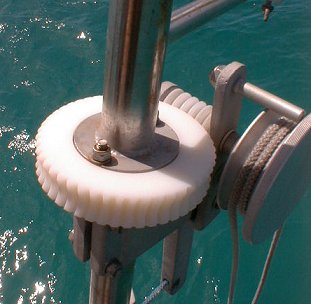 |
| These machined nylon gear wheels set and allow adjustment of the course. |
As detailed in the account of our recent Atlantic crossing we had some problems with the system jumping its adjustment gears in the gale-force squalls. Click here for page 5 of the Atlantic-crossing story where I discuss this. I imagine that I can prevent this by either shortening the leverage of the windvane itself (I have always extended it fully to position 3 in the past - it is set on 2 at the moment), or by adding a loop or two of rubber-bungee line to augment the force of the spring which maintains the mesh, or both. This is all untried at the moment and is my only outstanding worry.
The heavy swinging vane is always a worry when guests use the transom boarding ladder. They are often nervous enough about their hand- and foot-holds without getting a dangerous crack on the head from the spiky little butterfly nut which adjusts the windvane's leverage as mentioned above. We now know always to look out for it. It is not so much of a problem at anchor as it tends to stay close to fore-and-aft. The real problems are when moored away from pontoons in a harbour, as we were in Santa Cruz and as we would be regularly in the Mediterranean.
The Schwing-Pilot will hold a course under most wind and sea conditions and on most points of sail. The only exceptions to this statement in my experience have been:
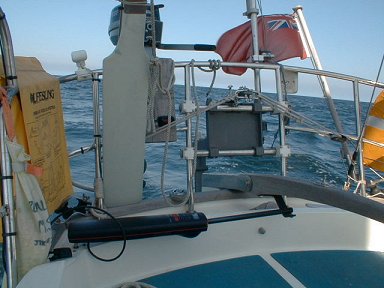 |
|
Raytheon do produce expensive 'ocean' versions of their higher-end Autopilots, but when I spoke to them about my 2000 model self-destucting, they said that it was never meant for such prolonged use. Windvane systems are simple, mechanical assemblies which can function day and night for years on end. Autopilots have their place when extreme accuracy in course-keeping is required close to land. You still need a backup unit though, as they can fail with no warning dur to water ingress, overheating, RF damage from the SSB, wear and tear etc. Note the view of the antifouled paddle from the Schwing-Pilot tied to the backstay behind the Autohelm. |
In both of these cases the trusty Autohelm electronic tiller pilot saved the day. We have an old Autohelm 1000, which is slow and stupid but never fails to work. We had a whizz-bang Autohelm 2000 which used to drive itself against its own internal end-stops so hard that it self-destructed after about two years. We now use a lovely new Autohelm 2000+ which is very clever (including being able to track us directly to a GPS waypoint automatically using its NMEA data link). We hope it has the common sense not to self-destruct like its forebear did. Even in waypoint-tacking mode the 2000+ is immune to 100 Watt HF SSB transmissions on board. The live antenna wire actually crosses both the power and data links below deck, but I have arranged for them to cross at right angles to minimise pick-up.
Regardless of wind and sea-state we always switch to electronic steering during the first and last days of a passage when we are close to land and pilotage requires closer course-keeping than the wind-vane can provide. Out at sea the windvane is superior even without taking account of the power consumption and the wear and tear: It maintains our apparent wind angle so that the sails are always correctly set between look-outs. Our course may deviate but the compass and GPS both warn of that from the chart-table.
On the whole I am very happy with this purchase. I was put onto this supplier by Kevin Seymour, previously of Northshore Yachts Ltd who built the boat. It fits very neatly over the transom-hung rudder of the Vancouver and works very well on all points of sail. The only worry I have outstanding is the issue over the gear-mesh which will only next be tested when the windspeed next gets up into the high 30s while we're at sea.
The unit cost me DM4950.00 including air-freight to Jersey, UK in 1995. At the time, this translated into £2277.00 sterling. The only problem for other propective buyers may be the language barrier if, like me, they are not German speakers.